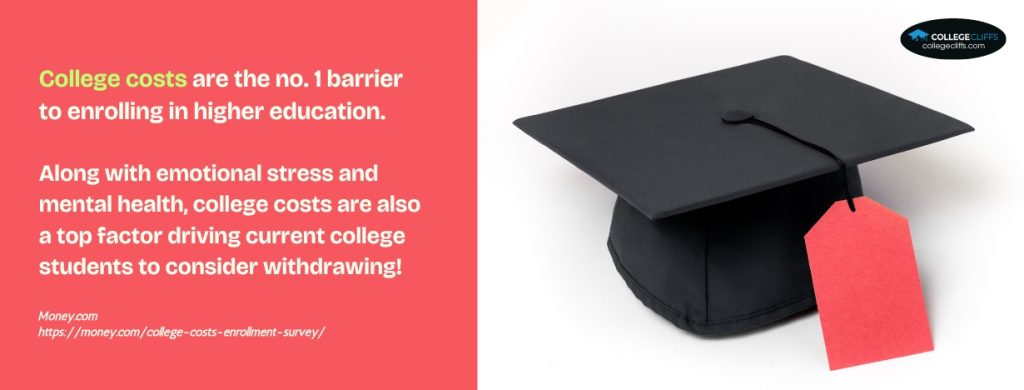College Tuition vs. Sticker Price vs. Net Price
Find your perfect college degree
In this article, we will be covering...
One of the most common misconceptions is that college tuition is the total cost of attending a college. Many don’t consider other costs like room and board, transportation, textbooks, and miscellaneous and upkeep fees. So, if you think you understand the costs of attending a college, nine out of ten, you don’t.

The landscape of college expenses is more intricate than meets the eye, with variables like sticker price and net price adding layers of complexity to the financial equation. In this article, we’ll take a closer look at the definitions of “college tuition,” “sticker price,” and “net price.”
We’ll explore the distinctions between these terms and unravel the complexities surrounding the true cost of attending college.
College tuition, sticker price, and net price are three terms that are often interchanged among new students. Understanding the differences between these terms is crucial for making informed decisions about attending college and determining the true cost of education.
What is College Tuition?

College tuition is only one of the several components that affect the total cost of higher education, but it’s typically the highest amount you’ll need to pay. It represents the amount of money a student must pay for academic instruction.
Tuition varies from college to college. But typically, public schools offer more affordable tuition than private schools. Moreover, in-state students are bound to have lower tuition charges than their out-of-state counterparts— although not always the case.
Private schools are known to charge the same tuition rates for in-state and out-of-state students, while public schools charge more for non-residents.
There are several reasons why public schools charge higher for out-of-state students. For one, these schools are government-funded, which means that the resources they’re using to run the school are obtained from the taxes locals pay.
In-state students and their families contribute to this funding through various taxes, such as income and property taxes. As a result, charging lower tuition for in-state students is often considered a way of ensuring that state residents receive a return on their investment through affordable education.
Nevertheless, non-residents still have the opportunity to pay in-state tuition in public colleges and universities. Here are a few ways to avail in-state tuition as an out-of-state student:
- Through reciprocity agreements: Reciprocity or exchange programs let students attend public schools in other participating states without paying the full out-of-state tuition. There might be a cap on the number of students accepted into the program. Out-of-state students will probably still pay more than in-state students, but it won’t be as big as if they were to enroll in a non-participating state. A few rules apply to this, including that the major/degree the out-of-state student is pursuing is not offered in-state.
- Obtaining residency: A student who has lived in a state for at least a year before enrolling in school may be eligible for in-state tuition status, depending on the state or the school. There will be conditions, such as the student’s declaration that they plan to remain in the state permanently. They will require documentation confirming their residence, such as a driver’s license, voter registration, a local bank account, or a local job. But that might not always be the case. If the young student is deemed to be a “dependent,” the school may consider the parent’s place of residence when determining whether to charge the student at the out-of-state rate. Certain schools offer reduced tuition if you reside near the state border.
- Good grades: High academic achievement can earn in-state tuition at out-of-state schools, as some state schools allow students with high grade point averages or academic scholarships to pay in-state rates.
- Special circumstances: Children of alumni are often given special discounts, including in-state tuition. If you’re a veteran or an immediate relative of one, you may also qualify for tuition discounts in schools participating in the Yellow Ribbon Program.
What is a Sticker Price?

“Sticker price” is the published cost of attending a college or university but doesn’t factor in every single fee. Typically, this includes the cost of tuition, room and board, book, and miscellaneous fees. If you’re learning online, it may also include the fees for distance learning. This is where students and parents often get confused because they think that the published price is the actual cost.
The sticker price can be intimidating, often reaching tens of thousands of dollars per year. However, it’s crucial to understand that the sticker price does not necessarily reflect the amount a student will actually pay. This is just the estimated amount of what students will pay. But in rare cases, it is the actual price, especially for students who do not apply for financial assistance.
Public schools have lower sticker prices than private schools. According to the Education Data Initiative, four-year public schools have an average cost of $26,027, while private, nonprofit schools climb up to $55,840.
What is Net Price?

The net price refers to the actual cost of attending a college, representing the amount a student should expect to pay out of pocket. Although a school’s sticker price might serve as a helpful guide, college students rarely pay the entire amount. This is where the importance of exhausting all financial assistance (free money that is not covered under sticker price) becomes necessary.
The goal of financial aid is to cover the shortfall between your family’s income and the expense of college. According to the National Center for Education Statistics (NCES), over 87% of students receive financial aid.
The equal access principle, which states that everyone should be able to attend college regardless of financial situation, is the foundation of the financial aid system. The way the system is set up, students and their families are supposed to pay as much of the tuition as possible. Financial aid options, such as grants, loans, and scholarships, are available to cover the difference if a family is unable to cover the total cost.
Financial aid consists of the following:
- Grants: Grants are non-repayable financial aids, such as Pell Grants, FSEOG, TEACH Grants, and Iraq and Afghanistan Service Grants, available to students unless they withdraw or fail to fulfill service obligations.
- Scholarships: Nonprofit and private organizations provide scholarships to students based on academic merit or talent to help manage education expenses.
- Work-Study Jobs: The Federal Work-Study Program allows part-time work to pay for school, with potential earnings based on job type and skills, and depends on application, financial need, and school funding.
- Loans: A student loan is a type of financial aid offer from a school, requiring repayment of the borrowed money and accruing interest. Understanding repayment options is crucial for successful repayment.
Schools often also provide financial aid through grant or scholarship funds. To find available financial assistance, visit the school’s website, contact the financial aid office, inquire about department scholarships, and complete necessary applications.
One of the most common myths about private and public colleges is that the former is much more expensive. While it’s partially true, it’s not always the case. The belief that public colleges are always more affordable is outdated, as tuition is rising across the board.
Certain students may find attending a public school to be less expensive than attending a private one. But, since private schools do not rely on the government’s funds, they often have bigger and better financial aid programs that make them significantly more affordable than their tuition figures might suggest. In fact, the most talented students in private schools are paying low to zero tuition and fees!
Public schools don’t have much room to wiggle for financial assistance since they operate within fixed budgets. However, private colleges and universities can tailor financial aid packages to individual needs. Additionally, private schools often have alumni networks and endowments that contribute to their ability to provide financial assistance.
Generous donors and alumni who are invested in the success of the institution may contribute to scholarship funds, allowing the school to support a broader range of students. This flexibility allows them to consider factors beyond just income, such as academic achievements, extracurricular involvement, and special talents.
But then again, every student is different. What works for others may not work for you.
The best strategy to determine which institution type best suits you is to learn about the college’s financial aid footprint. This will provide you with the sticker price of the college, the average amount of financial aid awarded to each student, and the average student cost.
You will receive an estimated net price as a result. You can use College Navigator as a source.
Finding the Net Price for a College
Finding the net price for a college is not an easy task. You may need to seek professional help from school or financial aid counselors who can guide you through the process.
As experts, they are well-versed in navigating the complex world of college expenses and can provide valuable insights into available grants, scholarships, and financial aid options.
Another method is to learn how to use a Net Price Calculator. Start with the list price and add all applicable taxes and other government-mandated fees to arrive at the net price. Subtract any rebates, discounts, or negotiated rates after that to know the final net price.
The majority of institutions feature a net price calculator on their website that asks you a series of questions regarding your academic performance, assets, household size, family income, and other variables. You can also use the US Department of Education Net Price Calculator.
Net price calculators vary in accuracy, with the least reliable ones being those based on the federal calculator template, which schools can use for free. These calculators don’t ask about family assets, student assets, or income figures, making the resulting net price unreliable.
The most accurate calculations require specific figures on tax returns and relevant assets.
Summary Points
- College tuition is the highest component, while sticker price includes all fees. Net price represents the actual cost after financial aid.
- Public schools offer lower sticker prices, but private schools often provide better financial aid packages.
- 87% of students in US colleges and universities receive financial aid.
Additional Information:




